Baseball Equipment Market Size
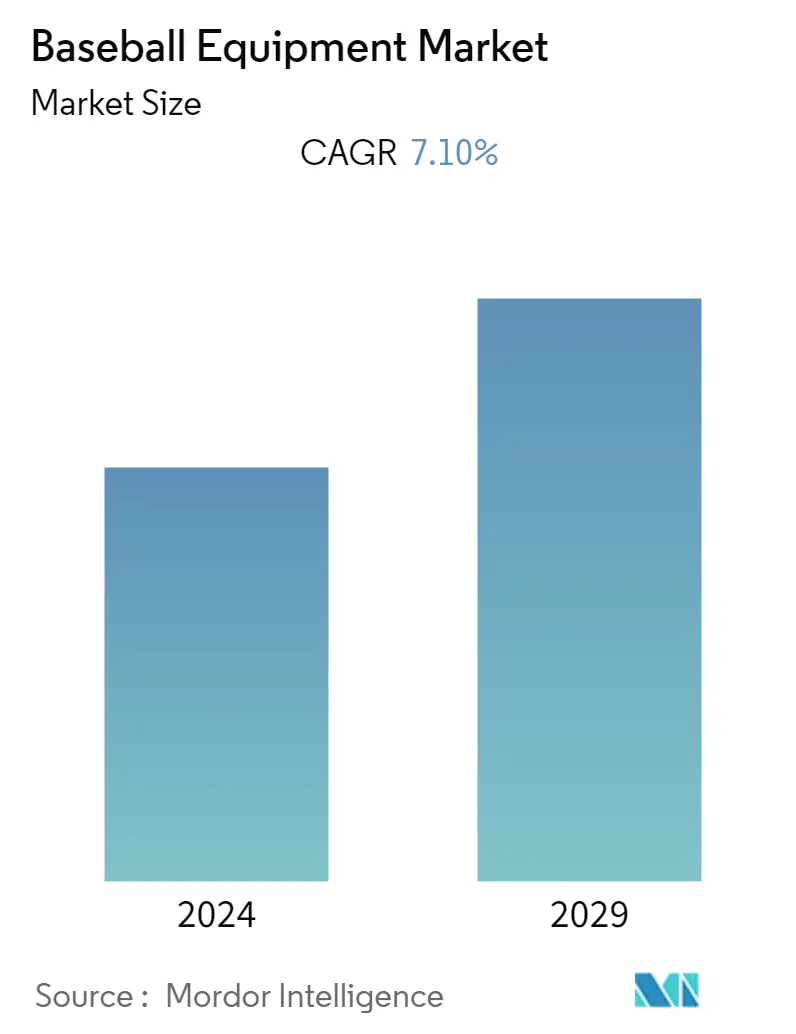
| Study Period | 2019 - 2029 |
| Base Year For Estimation | 2023 |
| CAGR | 7.10 % |
| Fastest Growing Market | Asia-Pacific |
| Largest Market | North America |
| Market Concentration | Low |
Major Players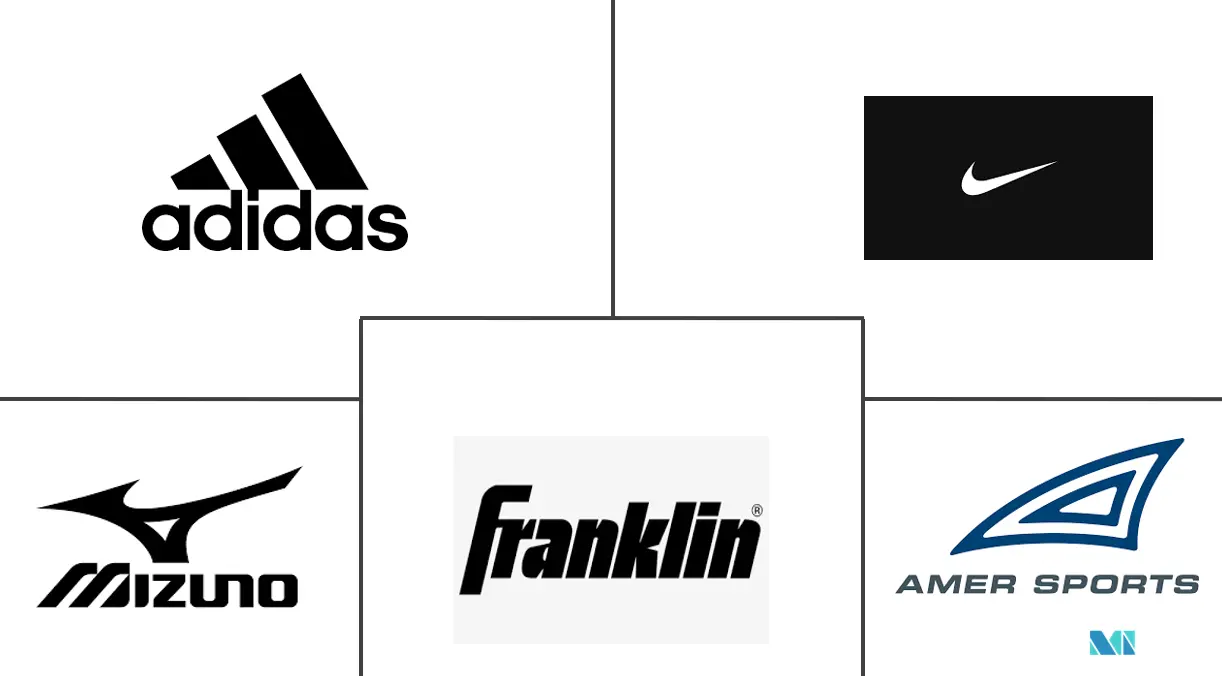
*Disclaimer: Major Players sorted in no particular order |
Baseball Equipment Market Analysis
The baseball equipment market is projected to register a CAGR of 7.1% during the forecast period.
Baseball is one of the most common sports that has served consumers with entertainment. The participation rate in baseball has significantly grown in the recent past. Moreover, an increasing number of sports clubs and associations has further raised the number of regional-level and state-level tournaments and championships in baseball. For instance, Major League Baseball (MLB) is a professional baseball organization that is composed of 30 teams and conducts numerous baseball tournaments across the world. This, in turn, accelerates the sales of baseball equipment and drives the growth of the market studied.
Further, the rising government initiatives to promote participation in baseball are expected to create lucrative market opportunities during the forecast period. For instance, in early 2020, as a part of its 'Sporting Schools' initiative, the Australian government successfully introduced baseball to several schools in the region. In addition, the use of helmets and gloves has been part of the game rule to ensure the safety and comfort of the players on the field, influencing the demand in the baseball equipment market.
However, during the COVID-19 pandemic, baseball tournaments ceased. This had a negative impact on the growth of the baseball equipment market. For instance, Minor League Baseball's 2020 season was canceled to ensure the safety of participants and the audience. Thus, sporting equipment companies, including baseball equipment providers, witnessed a steep decline in their market shares in the early months of the pandemic.
Baseball Equipment Market Trends
This section covers the major market trends shaping the Baseball Equipment Market according to our research experts:
Increased Participation Rate
With the development of baseball sports worldwide, participation in baseball leagues also increased among the population. According to the British Baseball Federation, there were nearly 22,500 baseball players across the United Kingdom in 2020. The increasing participation rates of baseball in the North American region reflect the growing popularity of the game across various countries. It was reported that the United States had the highest number of baseball players over the study period, with over 52.8% of the country's participation playing baseball since it launched. Therefore, several baseball events and leagues have been established in recent years. For example, in May 2022, Major League Baseball (MLB) Players Inc. and Sorare unveiled the partnership to launch the first Major League Baseball NFT-based free-to-play game. Moreover, the development of baseball courses across the world has been continuous during the study period. This led to the rising demand for baseball equipment, propelling the growth of the market studied over the forecast period.
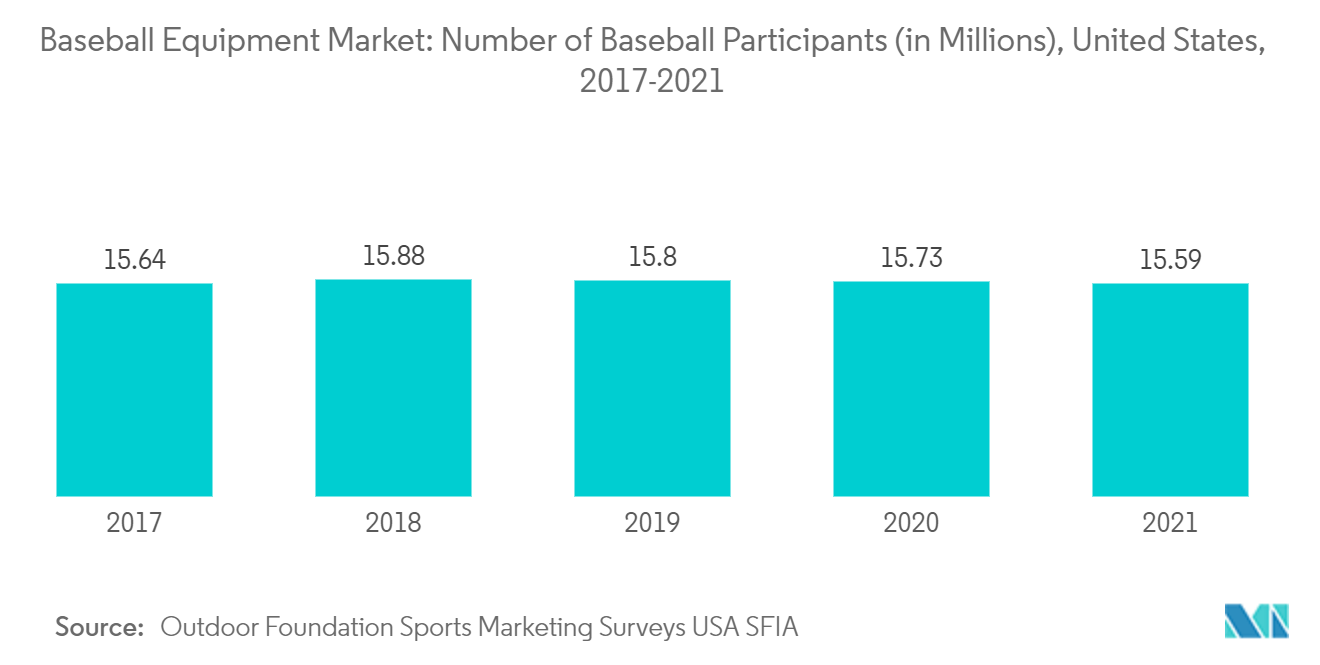
North America is the Largest Region
The connection between Americans and baseball is enduring and has always been on the cutting edge of new technologies and innovations. Owing to the presence of an aggregate volume of baseball spectators in the North American region, the need for baseball equipment is high over the region. Moreover, the region owns special baseball grounds, captivating the consumer's interest in the respective game. Subsequently, the baseball associations in the region are engaged in implementing different innovations to counteract the problems faced by the baseball leagues. For instance, in 2021, the American Association of Professional Baseball launched a new website (AABasball.com) to host all the league's digital assets and enable fans to connect with every American Association team using its new website as the central hub for all league content. Therefore, the establishment of baseball leagues associated with an increasing number of baseball grounds further accelerates the population's participation in baseball. This is expected to drive the sales of baseball equipment over the forecast period.
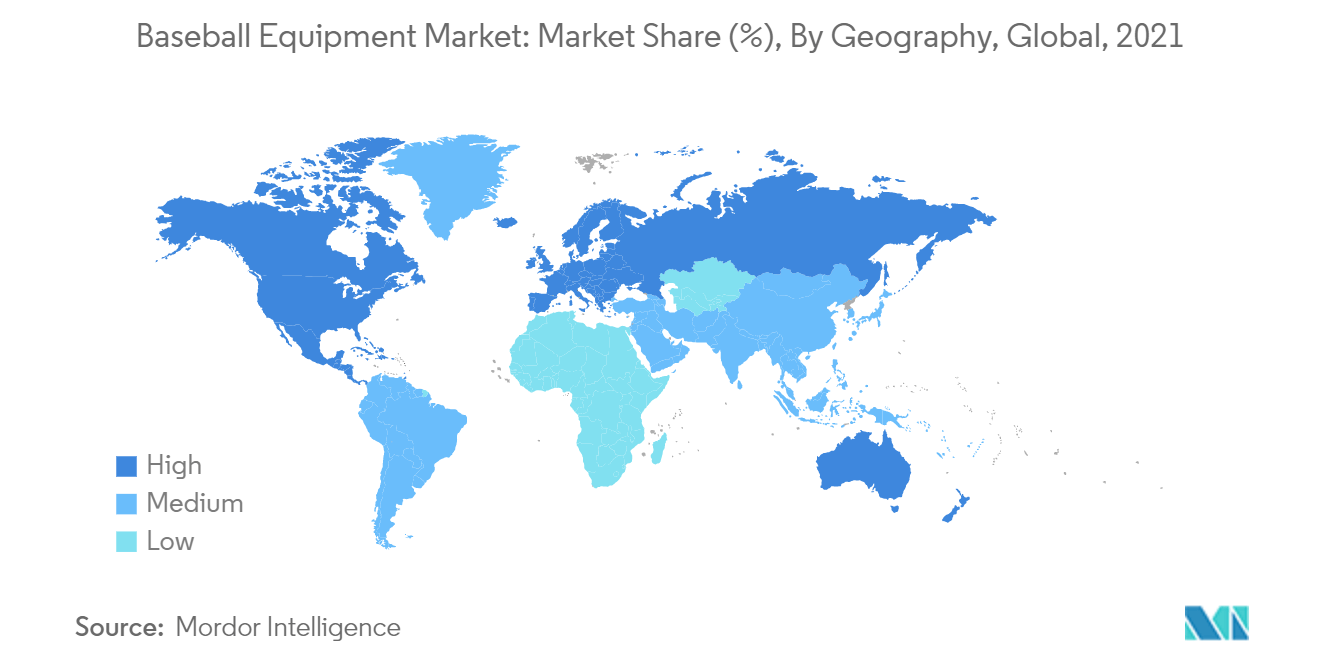
Baseball Equipment Industry Overview
The baseball equipment market is highly competitive in nature due to the presence of domestic and international players. Major players identified in the global baseball equipment market include Adidas AG, Franklin Sports Inc., Nike Inc., Amer Sports Oyj, and Mizuno Corporation. These companies focus on new product launches and expanding distribution networks to cater to consumers across different regional markets. For instance, in 2022, DeMarini Sports Inc. launched the RAYZR'D DeMarini logo serves to usher in a new generation of innovative baseball bats.
Baseball Equipment Market Leaders
-
Adidas AG
-
Nike, Inc.
-
Franklin Sports Inc.
-
Amer Sports Oyj
-
Mizuno Corporation
*Disclaimer: Major Players sorted in no particular order
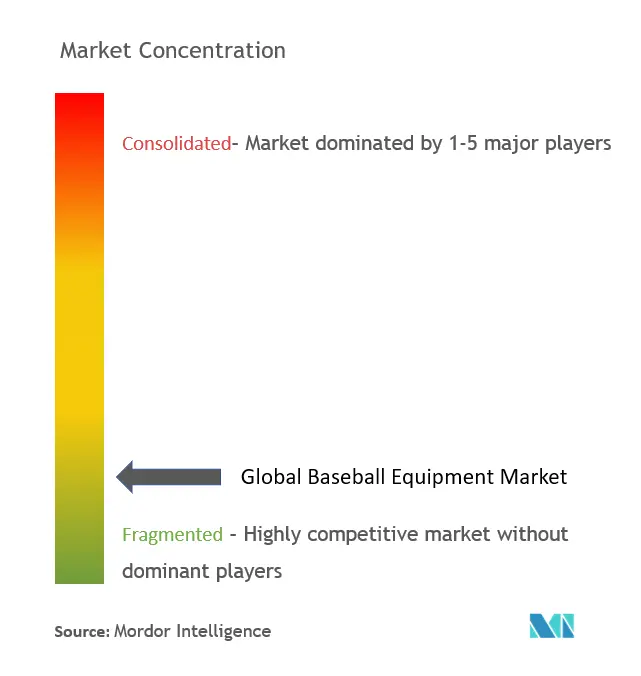
Baseball Equipment Market News
- in July 2022, Rawlings Sporting Goods Company, Inc. launched its new digital venture marking the first of its kind for the long-established baseball and softball brand under the product category of baseball gloves.
- In September 2021, BRG Sports' brand Easton launched its Easton's 2022 bat line-up across all certifications, including the release of the 2022 ADV Hype, the brand's most technological take on a two-piece composite bat. The company's major focus behind launching its new product was to enlarge its business by involving new products in the product catalog.
- In March 2021, the United Kingdom-based Baseball Outlet announced that the outlet was named an Offical Equipment Suppliers for Baseballsoftball UK (BSUK) events and its programs. Moreover, it will be the BSUK's primary supplier of all kit and equipements through atleast 2024. Baseball Outlet is a specialist supplier of sports equipment and clothing including bats, gloves, custom team jersey and works with leading brands including Easton Rawlings, Adidas, Wilson, DeMarini, and Evoshield.
Baseball Equipment Market Report - Table of Contents
1. INTRODUCTION
- 1.1 Study Assumptions and Market Definition
- 1.2 Scope of the Study
2. RESEARCH METHODOLOGY
3. EXECUTIVE SUMMARY
4. MARKET DYNAMICS
- 4.1 Market Drivers
- 4.2 Market Restraints
-
4.3 Porter's Five Forces Analysis
- 4.3.1 Threat of New Entrants
- 4.3.2 Bargaining Power of Buyers/Consumers
- 4.3.3 Bargaining Power of Suppliers
- 4.3.4 Threat of Substitute Products
- 4.3.5 Intensity of Competitive Rivalry
5. MARKET SEGMENTATION
-
5.1 Products Type
- 5.1.1 Bat
- 5.1.2 Ball
- 5.1.3 Helmet
- 5.1.4 Gloves
- 5.1.5 Other Products Types
-
5.2 Distribution Channel
- 5.2.1 Supermarkets/Hypermarkets
- 5.2.2 Speciality Sports Stores
- 5.2.3 Online Stores
- 5.2.4 Other Distribution Channels
-
5.3 By Geography
- 5.3.1 North America
- 5.3.1.1 United States
- 5.3.1.2 Canada
- 5.3.1.3 Mexico
- 5.3.1.4 Rest of North America
- 5.3.2 Europe
- 5.3.2.1 United Kingdom
- 5.3.2.2 Germany
- 5.3.2.3 Spain
- 5.3.2.4 France
- 5.3.2.5 Italy
- 5.3.2.6 Russia
- 5.3.2.7 Rest of Europe
- 5.3.3 Asia-Pacific
- 5.3.3.1 China
- 5.3.3.2 Japan
- 5.3.3.3 India
- 5.3.3.4 Australia
- 5.3.3.5 Rest of Asia-Pacific
- 5.3.4 South America
- 5.3.4.1 Brazil
- 5.3.4.2 Argentina
- 5.3.4.3 Rest of South America
- 5.3.5 Middle East and Africa
- 5.3.5.1 Saudi Arabia
- 5.3.5.2 South Africa
- 5.3.5.3 Rest of Middle East and Africa
6. COMPETITIVE LANDSCAPE
- 6.1 Most Adopted Strategies
- 6.2 Market Share Analysis
-
6.3 Company Profiles
- 6.3.1 Adidas AG
- 6.3.2 Amer Sports Oyj
- 6.3.3 Franklin Sports Inc.
- 6.3.4 Mizuno Corporation
- 6.3.5 Nike Inc.
- 6.3.6 BRG Sports
- 6.3.7 Wilson Sports Goods
- 6.3.8 Marucci Sports
- 6.3.9 Rawlings Sporting Goods
- 6.3.10 Majestic Athletic
- *List Not Exhaustive
7. MARKET OPPORTUNITIES AND FUTURE TRENDS
8. IMPACT OF COVID-19 ON THE MARKET
9. DISCLAIMER
** Subject To AvailablityBaseball Equipment Industry Segmentation
Baseball equipment is a type of sports equipment that is specifically designed for playing baseball.
The baseball equipment market is segmented by product type, distribution channel, and geography. By product type, the market is segmented into bat, ball, helmet, glove, and other product types. By distribution channel, the market is segmented into supermarkets/hypermarkets, specialty sports stores, online stores, and other distribution channels. It provides an analysis of emerging and established economies across the world, comprising North America, Europe, South America, Asia-Pacific, and Middle East and Africa. For each segment, the market sizing and forecasts are provided in terms of value in USD million.
| Products Type | Bat | |
| Ball | ||
| Helmet | ||
| Gloves | ||
| Other Products Types | ||
| Distribution Channel | Supermarkets/Hypermarkets | |
| Speciality Sports Stores | ||
| Online Stores | ||
| Other Distribution Channels | ||
| By Geography | North America | United States |
| Canada | ||
| Mexico | ||
| Rest of North America | ||
| By Geography | Europe | United Kingdom |
| Germany | ||
| Spain | ||
| France | ||
| Italy | ||
| Russia | ||
| Rest of Europe | ||
| By Geography | Asia-Pacific | China |
| Japan | ||
| India | ||
| Australia | ||
| Rest of Asia-Pacific | ||
| By Geography | South America | Brazil |
| Argentina | ||
| Rest of South America | ||
| By Geography | Middle East and Africa | Saudi Arabia |
| South Africa | ||
| Rest of Middle East and Africa |
Baseball Equipment Market Research FAQs
What is the current Baseball Equipment Market size?
The Baseball Equipment Market is projected to register a CAGR of 7.10% during the forecast period (2024-2029)
Who are the key players in Baseball Equipment Market?
Adidas AG, Nike, Inc., Franklin Sports Inc., Amer Sports Oyj and Mizuno Corporation are the major companies operating in the Baseball Equipment Market.
Which is the fastest growing region in Baseball Equipment Market?
Asia-Pacific is estimated to grow at the highest CAGR over the forecast period (2024-2029).
Which region has the biggest share in Baseball Equipment Market?
In 2024, the North America accounts for the largest market share in Baseball Equipment Market.
What years does this Baseball Equipment Market cover?
The report covers the Baseball Equipment Market historical market size for years: 2019, 2020, 2021, 2022 and 2023. The report also forecasts the Baseball Equipment Market size for years: 2024, 2025, 2026, 2027, 2028 and 2029.
Baseball Equipment Industry Report
Statistics for the 2024 Baseball Equipment market share, size and revenue growth rate, created by Mordor Intelligence™ Industry Reports. Baseball Equipment analysis includes a market forecast outlook to 2029 and historical overview. Get a sample of this industry analysis as a free report PDF download.



